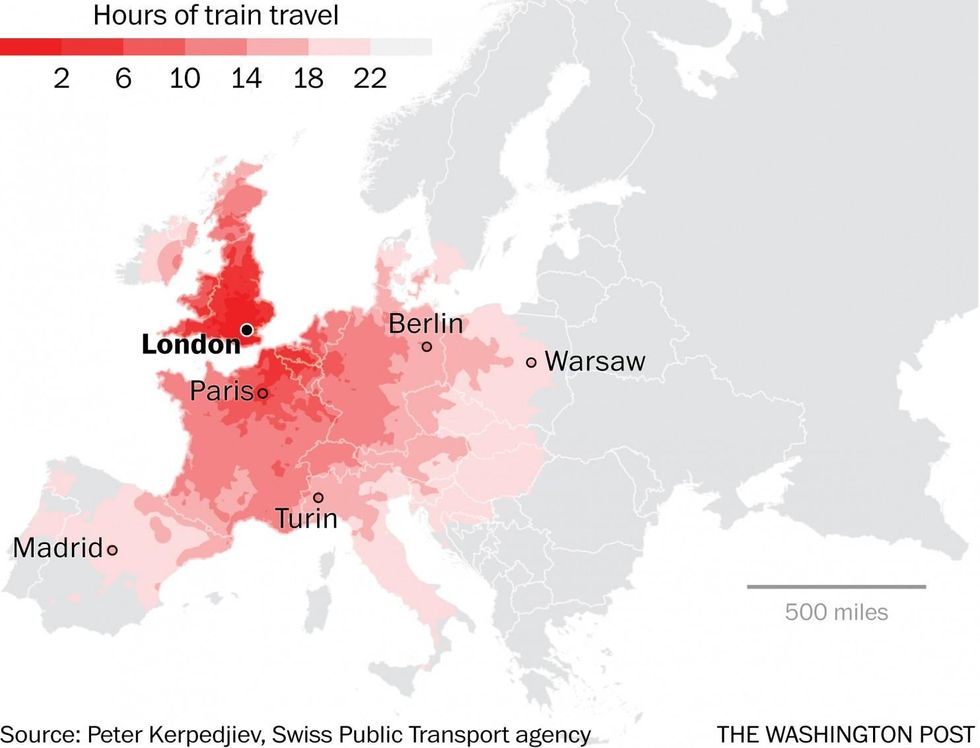News

Peter Kerpedjiev, Swiss Public Transport Agency
Tourists visiting Europe are often advised to travel by train rather than plane or car. Trains are considered reliable, fast and relatively cheap.
But as a new research project shows, there are major differences within Europe: Whereas you can travel from London to Paris in less than four hours, traveling the same distance can last more than 22 hours in eastern Europe.
Peter Kerpedjiev, a PhD student at the University of Vienna in Austria, gathered data that offers stunning insights into Europe's railway network. He selected 28 European cities and illustrated which surrounding cities or areas could be reached within a certain time.
The following maps illustrate the most striking conclusions that can be drawn from Kerpedjiev's data.
If you prefer fast rides, start somewhere close to Paris or London
Europe's fastest train network is located in the west of the continent. London, Paris and Brussels form a triangle connected by high-speed trains.
“I was really surprised how well connected Paris is. Both London and the Mediterranean coast are less than four hours away,” Kerpedjiev told The Washington Post.
Parisians do not only have easy access to their own country and London, but also to Germany. “Cologne is a little over three hours away, and most of the populous North Rhine-Westphalia region is less than six hours away. That's an enormous area that can be reached in less than half a day of travel,” Kerpedjiev said.
Eastern Europe is incredibly poorly connected
In comparison to Western Europe, the continent's east is lagging far behind in the development of its train network.
“It takes a little over eight hours to travel from Paris to Berlin by train, while the nearly equivalent distance between Sofia and Sarajevo takes 46 hours,” Kerpedjiev explained.
Whereas Belgrade in Serbia is still relatively well connected, Podgorica in Montenegro, for instance, is virtually cut off from the rest of Europe.
Scandinavia is surprisingly well connected
Despite a low population density, and long distances between the few large cities, the Scandinavian rail network is surprisingly fast.
From Sweden's Stockholm you can reach Norway's capital Oslo as well as Denmark's Copenhagen in less than eight hours.
Most of the data is based on information provided by the Swiss Public Transport agency. “One of the limits, however, is that not all timetables in Europe are available, and some connections are missing,” Kerpedjiev acknowledges.
What's the best train route for tourists, according to the data?
Based on his data visualizations, Kerpedjiev recommends that visitors start in London, Brussels or Paris and explore the cities by high-speed rail. Next, he would travel to Geneva, which is located in the Alps in Switzerland, using a high speed TGV connection.
Alternatively, one could decide to travel to Cologne, Hamburg or Berlin in Germany. You might end the trip in Copenhagen in Denmark.
Kerpedjiev himself would probably choose yet another option and take a night train from Paris to the Mediterranean coast or from Cologne to Prague and Vienna. “While slower than the high-speed trains, they have the enormous advantage of letting you sleep comfortably throughout your journey and wake up at your destination,” he explained.
You can see Kerpedjiev's original maps here.
Previous versions of these graphics showed isochrone maps for Minsk Mazowiecki, a town outside Warsaw, instead of the capital of Belarus.
Copyright: Washington Post
More: World War II warships have mysteriously disappeared from their watery graves
Top 100
The Conversation (0)

















